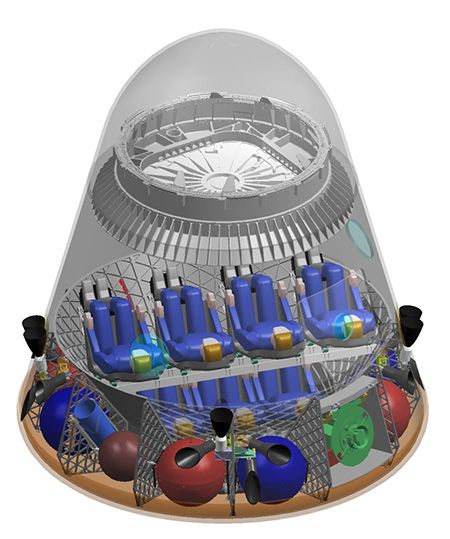This is cross-posted from my blog. This milestone by SpaceX is directly relevant to programs by Lifeboat such as the AsteroidShield and SpaceHabitat, and possibly also (eventually) to Space-Based Solar Power.
Stars My Destination
After the third try, Elon Musk, the founder of SpaceX, co-founder of Paypal, chairman of SolarCity and chairman of Tesla Motors (beat that resumé!) was interviewed by WIRED about the difficulties of making his space rockets reach orbit:
Wired.com: How do you maintain your optimism?
Musk: Do I sound optimistic?
Wired.com: Yeah, you always do.
Musk: Optimism, pessimism, fuck that; we’re going to make it happen. As God is my bloody witness, I’m hell-bent on making it work.
Falcon 1: The First Privately Developed Rocket to Orbit the Earth
Well kids, perseverance pays off. On the 4th try, the 70-foot Falcon 1 rocket reached orbit wit a 364-pound dummy payload: “The data shows we achieved a super precise orbit insertion — middle of the bullseye — and then went on to coast and restart the second stage, which was icing on the cake.” Check out the video of the highlights of the launch.
“This really means a lot,” Musk told a crowd of whooping employees. “There’s only a handful of countries on Earth that have done this. It’s usually a country thing, not a company thing. We did it.”
Musk pledged to continue getting rockets into orbit, saying the company has resolved design issues that plagued previous attempts.
Last month, SpaceX lost three government satellites and human ashes including the remains of astronaut Gordon Cooper and “Star Trek” actor James Doohan after its third rocket was lost en route to space. The company blamed a timing error for the failure that caused the rocket’s first stage to bump into the second stage after separation.
SpaceX’s maiden launch in 2006 failed because of a fuel line leak. Last year, another rocket reached about 180 miles above Earth, but its second stage prematurely shut off.
The Falcon 1, at $7.9 million each, is what you could call the budget model. In fact, $7.9 million is basically pocket changed compared to what government agencies like NASA are used to paying to contractors like Lockheed Martin & co.
SpaceX is also working on the Falcon 9 (12,500 kg to low Earth orbit, and over 4,640 kg to geosynchronous transfer orbit) and Falcon 9 Heavy (28,000 kg to low Earth orbit, and over 12,000 kg to geosynchronous transfer orbit) to help NASA reach the International Space Station, among other things. These should cost between $36.75 million and $104 million each depending on the model and mission, and the first launch is scheduled for the first quarter of 2009.

Dragon Capsule
SpaceX is also developing a capsule capable of carrying up to 7 passengers. It is called Dragon and will be able to dock with the International Space Station. Pressurized Cargo/Crew capacity is 2500+ kg and 14 cubic meters, it is designed for water landing under parachute for ocean recovery.
There will also be another version of the capsule called DragonLab around 2010. It will be “available to researchers and other payloads as a free-flying space platform capable of staying in space from one week to two years.”
Next, the Moon
But that’s not all. SpaceX is also advertising the capabilities of its launchers to carry payloads to the moon.

There are numerous ways to utilize SpaceX launch services for lunar missions. Depending on the program requirements, several variables such as time, mass, complexity, and cost can be traded to provide different options for a successful lunar mission. If time is a driving force, spacecraft can be placed directly into a lunar transfer orbit aboard the Falcon 9 launch vehicle, arriving at the lunar injection point within 2‐3 days. However, if budget is of primary concern, the Falcon 1/Falcon 1e can be employed for injection into a Highly Elliptical Orbit (HEO). A kick motor on the spacecraft can then provide the necessary delta‐v to complete the Trans Lunar trajectory. Other low‐energy transfers utilizing weak stability boundaries can also be employed if time is not a driving requirement.
These rockets will no doubt be very useful to entrants in the Google Lunar X Prize (“The Google Lunar X PRIZE is a $30 million competition for the first privately funded team to send a robot to the moon, travel 500 meters and transmit video, images and data back to the Earth”).
A Competitive Market for Space
It’s great to see space exploration getting more affordable. Just like with computers, there was a phase when governments where the only ones who could afford the costs, but we can expect the next phase to be much more interesting, with a faster pace of innovation (just think, SpaceX was founded in 2002) and much lower costs because of market forces.

Sources:
See also:

This is all pretty fascinating. Had no idea of this guy (the co founder of Paypal, to boot!), and that he was out here building his own spacecrafts to send whereverthehell. Cool to know!